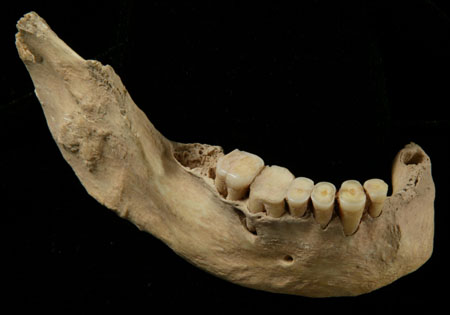New finding denies Chinese ancestor from Africa
(Xinhua)Updated: 2007-04-03 09:48
WASHINGTON -- Chinese and US researchers have reported the finding of an approximately 40,000-year-old early modern human skeleton in China, indicating that the "Out of Africa" dispersal theory of modern humans may not be as simple as was previously thought.
 Fossil of a mandible bone found in the Tianyuan Cave, Zhoukoudian, in suburs of Beijing. [Xinhua]  |
The findings were published Monday on the online issue of the journal Proceedings of the National Academy of Sciences.
Hong Shang, from the Institute of Vertebrate Paleontology and Paleoanthropology, Chinese Academy of Sciences and Washington University, St. Louis, MO., and colleagues examined a skeleton recovered in 2003 from the Tianyuan Cave, Zhoukoudian, in suburb of Beijing, China.
The skeleton dates to 42,000 to 38,500 years ago, making it the oldest securely dated modern human skeleton in China, and one of the oldest modern human fossils in eastern Eurasia, according to the researchers.
The specimen is basically a modern human, but it does have a few archaic characteristics, particularly in the teeth and hand bones, Hong Shang told Xinhua.
Based on this finding, the researchers say it is unlikely that a simple eastward spread of modern humans from Africa occurred, especially because slightly younger skeletons have been found in eastern Eurasia with similar mixes of features.
The Tianyuan skeleton suggests a gene flow occurred from the west and south.
The researchers say the Tianyuan skeleton also provides data on many aspects of its biology and will be useful for reconstructing the transition from archaic to modern humans in eastern Eurasia.
|
||
|
||
|
|